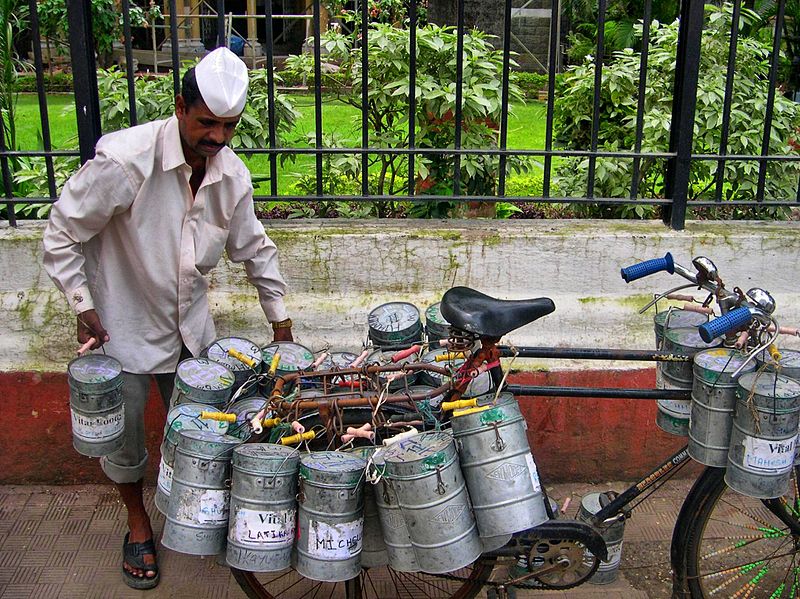Dabbawala

The man pictured above is a dabbawala. The two dozen or so metallic cylindrical containers — most often made of tin or aluminium — are called dabbas. There are 4,500 to 5,000 dabbawalas riding around every alley and street of Mumbai, India, virtually every day, even during monsoon season. Collectively, the dabbawalas traffic as many as 200,000 dabbas each day.
But don’t worry. They’re delivering lunch.
Translated literally, “dabbawala” means “box person” or perhaps “one who carries a box.” A “dabba” is a box — in this case, a bit of a misnomer because the “boxes” used are clearly cylinders — while “wala” is a suffix for a doer, signifying that the person is one who does something with the item. In this sense, a dabbawala is simply a food delivery guy, which sounds like a rather pedestrian (pardon the unintentional reverse-pun) occupation. But in Mumbai, being a dabbawala isn’t just a job — it’s a skilled trade all to itself. And a highly successful one at that.
The dabbawala trade began in the mid- to late-1800s during the British Raj, the British rule of India. Many Britons who came to India did not enjoy the local cuisine and, therefore, wanted to eat a more familiar lunch (called “tiffins”) at work. But their offices did not have kitchens and carrying a lunch was either too cumbersome or simply beneath the generally aristocratic colonists. Transporting lunches from the homes of British colonists to their places of work became necessary, and a cottage industry cropped up. By 1890, a 100-person delivery company was running much of the lunch delivery business in the area, and over the course of the next half-century or so, the dabbawala industry formed a union, now known as the Nutan Mumbai Tiffin Box Suppliers Trust. Today, the business is still growing; in 2007, the New York Times reported that the dabbawalla industry was growing at five to ten percent annually.
Why is business so good? Mumbai’s traffic can be nightmarishly bad, making the trip from suburbs to city by car unworkable for most. Taking the train is a better option, but that makes it difficult to carry items, and the commute is so long that lunch would have to be prepared the night before. A small but meaningful percentage of Mumbai office workers chooses to let the network of dabbawalas handle the lunch part. Each day, one delivery person picks up lunch later in the morning, bicycles it and others on its route to the train, and another dabbawala transports the lunch the rest of the way. At 450 rupees per month — that’s about $8.25 — workers can get their home-cooked meals brought to them with nearly 100% reliability.
Yes, nearly 100%. The dabbawalas, who are often illiterate, navigate the roadways of Mumbai with incredible efficiency. As the Guardian noted, “Forbes awarded the humble dabba-wallahs a 6 Sigma performance rating, a term used in quality assurance if the percentage of correctness is 99.9999999 or more. In other words, for every six million tiffins delivered, only one fails to arrive. This error rate means in effect that a tiffin goes astray only once every two months.” And in 2011, when the team from Top Gear tried to beat a dabbawala delivery service by using a car instead of the train, they failed miserably.
The dabbawalas themselves earn 8,000 to 10,000 rupees per month (roughly $150-$175), or about 100,000 to 120,000 rupees annually. This is much higher than the per capita income in India — about 53,333 rupees (about $975) per year — but that’s not enough, many claim. Due to the higher cost of living in the Mumbai area, combined with recent upticks in inflation, the dabbawala union recently requested taxi operator permits for 2,000 of its 5,000 members.
Bonus fact: If Guy de Maupassant, a famous 19th century French writer, wanted his lunch delivered by dabbawala (putting aside that there are none in Paris, and certainly not when Maupassant was alive), he would have had them deliver the cooked meals to the base of Paris’ Eiffel Tower. But not because he liked the food at the Tower’s restaurant The Tower, completed in 1889, was not immediately well-received by many, and especially not Maupassant. As the New York Times noted, Maupassant “saw the tower as an affront to his nation’s proud cultural heritage and dined regularly in its restaurant because that was the one spot in Paris from which he didn’t have to look upon ‘this giant and disgraceful skeleton.'”
From the Archives: Allergic to Paris: An odd affliction which Maupassant would probably not enjoy finding out about.
Related: A three-tiered tiffin box. Not a bad way to carry one’s lunch.
